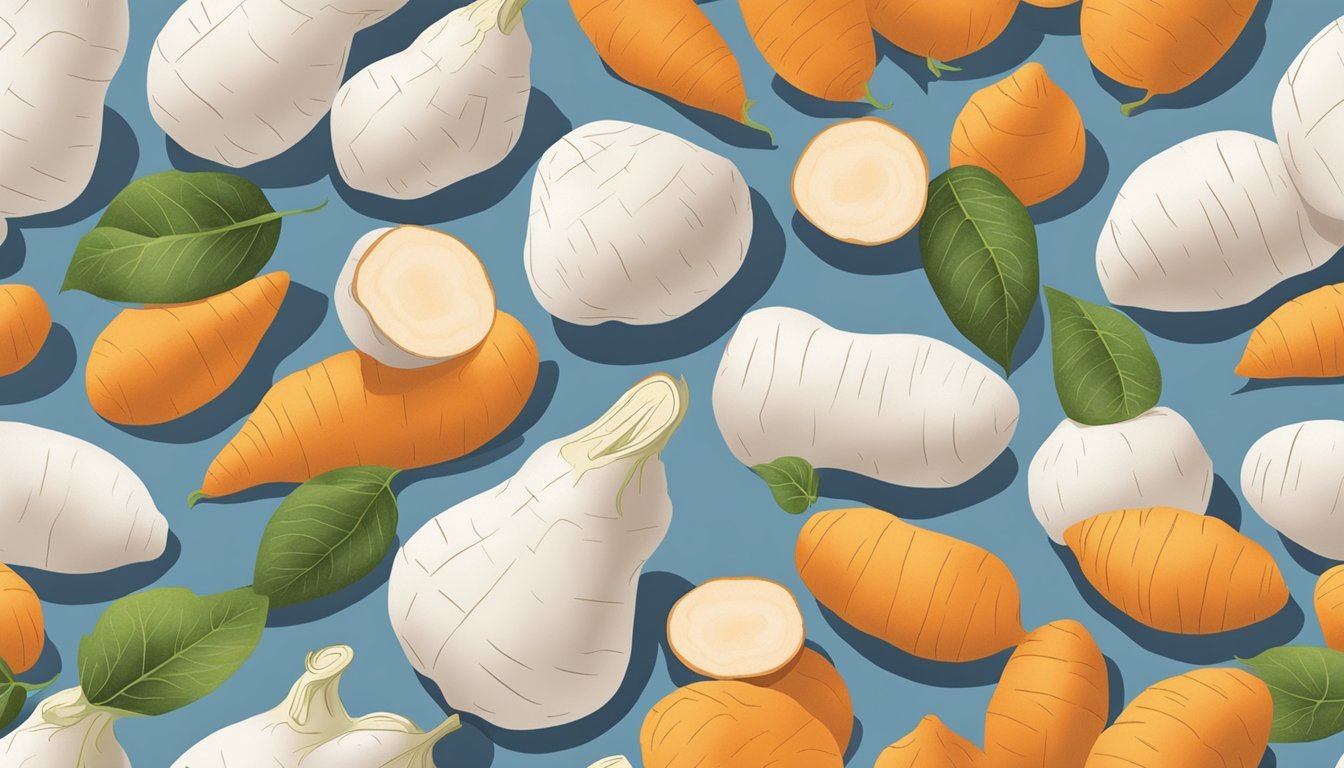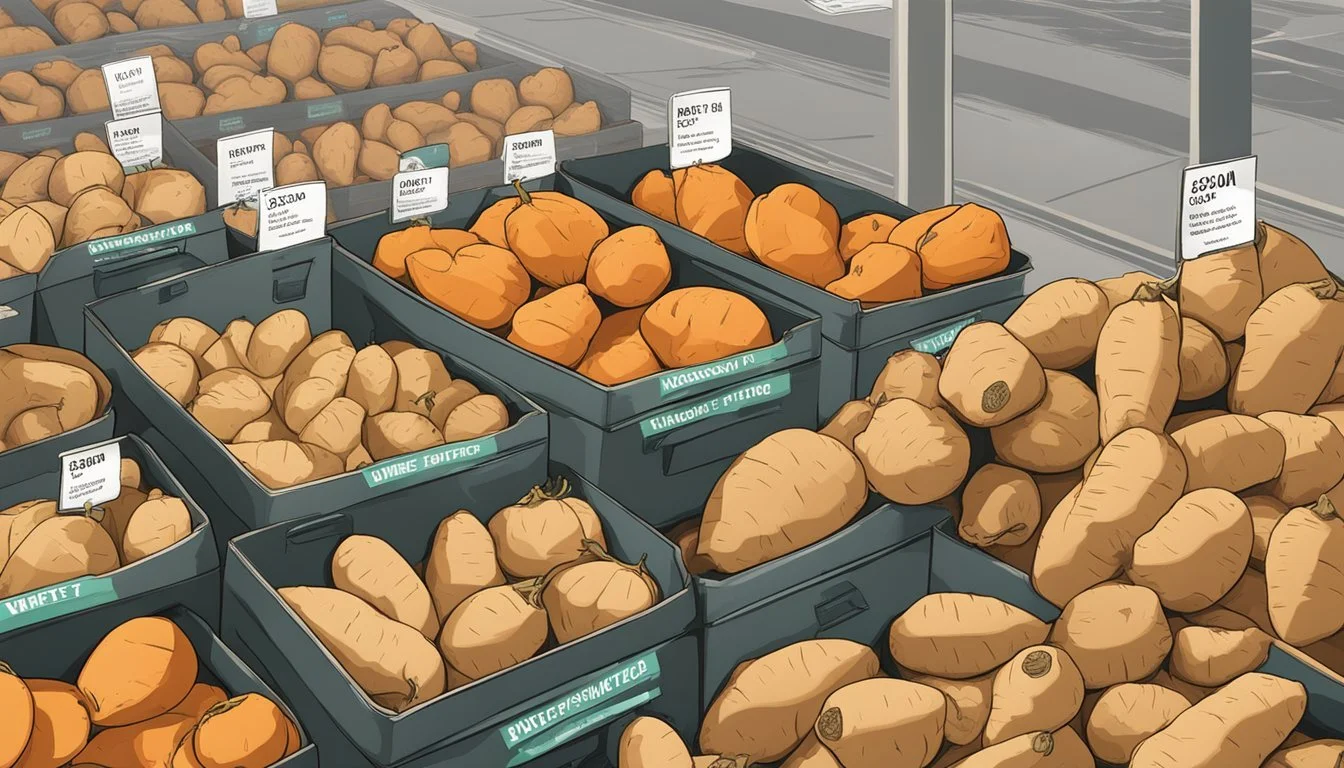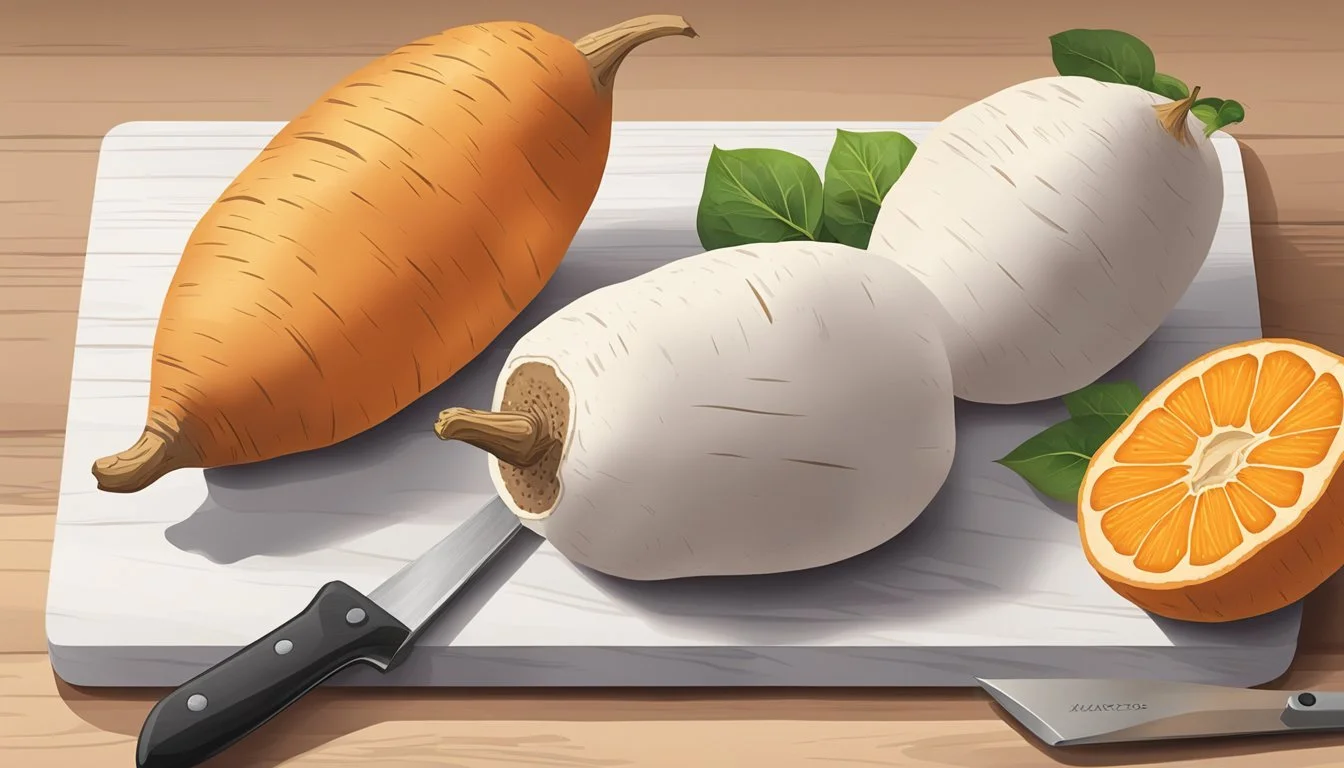How to Substitute White Sweet Potatoes for Orange Sweet Potatoes
A Simple Guide
Substituting white sweet potatoes (What wine goes well with sweet potatoes?) for orange sweet potatoes in cooking offers a twist on traditional flavors. White sweet potatoes are generally a suitable alternative to their orange counterparts, though their taste and texture vary slightly. Unlike orange sweet potatoes, which are known for their moist and sweet flavor, white sweet potatoes tend to have a drier texture and a more subtle, nutty taste. This difference does not pose a major challenge in recipes but may slightly alter the final taste of the dish.
When swapping in white sweet potatoes, one should consider their lower moisture content and milder flavor profile. They may require additional liquids in recipes to achieve the desired consistency. Their firmer texture after cooking makes them an excellent choice for dishes that require the potato to hold its shape, such as in salads or as a roasted side.
Nutritionally, both white and orange sweet potatoes offer health benefits, with white varieties being a good source of fiber and essential minerals like potassium, manganese, and magnesium. Although they lack the orange color indicative of beta carotene, white sweet potatoes still contribute valuable nutrients to one’s diet, making them a versatile and healthy option.
Understanding Sweet Potatoes
In this section, readers will gain insights into the diverse range of sweet potato varieties, their nutritional profiles, including their rich vitamin and mineral content, and the distinct attributes of white versus orange sweet potatoes.
Varieties of Sweet Potatoes
There is a broad array of sweet potato varieties, each with unique colors, textures, and flavors. Among them, the orange-fleshed sweet potatoes like Garnet and Jewel are the most familiar. They are often noted for their moist texture and sweet flavor. On the other hand, white sweet potatoes, which can be mistaken for regular potatoes due to their pale flesh, possess a different taste profile. The Japanese sweet potato is another variety, known for its purple skin and sweet flavor.
Nutritional Value and Health Benefits
Sweet potatoes are a powerhouse of nutrition, packed with essential vitamins, minerals, and antioxidants. They are particularly high in fiber, which promotes digestive health, and vitamin A, which is crucial for vision, immunity, and organ function. Here's a snapshot of their nutritional value:
Fiber: Essential for digestive health and satiety
Vitamin A: Supports vision and immune function
Antioxidants: Help reduce the risk of chronic diseases
Differences Between White and Orange Sweet Potatoes
White sweet potatoes and orange sweet potatoes differ mainly in two areas: flavor and nutritional content. Orange sweet potatoes are sweeter and moister than their white counterparts and have a higher beta-carotene content, which is a precursor to vitamin A. White sweet potatoes are less sweet with a more crumbly texture and, while they are nutritious, they contain less beta-carotene than orange varieties. Both can often be used interchangeably in recipes, though the subtle flavor differences should be considered to ensure the desired outcome of the dish.
Preparing for Substitution
When substituting white sweet potatoes for orange sweet potatoes, understanding the textural and flavor differences is essential to ensure successful culinary results.
Assessing Texture and Moisture Content
White sweet potatoes typically have a firmer and starchier texture compared to their orange counterparts, which often have a creamier texture. The moisture content in orange sweet potatoes is usually higher, contributing to a more tender final product. When preparing dishes that may rely on the softer texture of orange sweet potatoes—such as casseroles or pies—it is important to consider these textural differences. A cook may need to adjust cooking times or slightly alter the moisture components in their recipes, such as adding a bit more liquid to compensate for the drier texture of white sweet potatoes.
Sweet Potato Type Texture Moisture Content White Sweet Potato Firmer, Starchy Lower Orange Sweet Potato Softer, Creamy Higher
Taste Profile Comparison
In terms of taste, white sweet potatoes possess a milder flavor than the often sweeter orange sweet potatoes. The subtlety in the white variety's flavor profile may not only change the taste dynamic of a dish but can also be an advantage for those who prefer less sweetness. When substituting in recipes demanding the pronounced sweetness of orange sweet potatoes, one may want to add natural sweeteners like honey or maple syrup to achieve a comparable sweetness level. It is beneficial for a chef to taste the white sweet potatoes before incorporating them into a dish to assess their innate sweetness.
Key Taste Notes:
White Sweet Potatoes: Milder taste
Orange Sweet Potatoes: Richly sweet
Cooking Adjustments
When substituting white sweet potatoes for orange sweet potatoes, cooks may need to alter cooking times and temperatures, as well as adapt recipes to respect the textural differences and the subtle variation in sweetness.
Adjusting Cooking Times and Temperatures
White sweet potatoes are typically firmer and starchier than their orange counterparts. This difference can affect how quickly they cook. For instance:
Roasted Sweet Potatoes: White sweet potatoes may take slightly longer to become golden and crispy. Preheat the oven to 400°F and roast for approximately 30 to 35 minutes.
Boiled Sweet Potatoes: They might retain their firmness after the usual boiling time, so it's key to test with a fork for doneness and boil for an additional few minutes if necessary.
Baked Sweet Potatoes: The oven temperature should remain the same, but the baking times can be extended by 5 to 10 minutes, checking for a soft center.
Sweet Potato Fries: One might opt for a longer fry time to achieve the desired crispness, keeping the oil temperature around 350°F.
Adapting Recipes to Substitute Sweet Potatoes
Some recipes that call for orange sweet potatoes might change slightly in texture and taste when using white sweet potatoes.
Casseroles: They can be drier, so consider adding a little more of the wet ingredients to maintain a creamy texture.
Mashed Sweet Potatoes: While mashing, assess the consistency and add liquid as needed (such as milk or butter) for a creamy result.
Sweet Potato Pie: Due to the lower moisture content, cooks may increase the eggs or the dairy ingredients to achieve the iconic silky texture.
Substituting white for orange sweet potatoes is a matter of personal preference and recipe adjustment. One can confidently cook a variety of dishes, from roasted sweet potatoes to hearty casseroles, with a few thoughtful adjustments.
Recipe Modifications
When substituting white sweet potatoes for orange sweet potatoes, it is important to adjust recipes to accommodate the subtly different flavors and textures of white sweet potatoes. They are milder in sweetness and have a different moisture content, which can affect the final result of a dish.
Sweet Dishes
White sweet potatoes can be a suitable alternative in sweet dishes where the caramelized sweetness of orange sweet potatoes is not the primary flavor. For recipes like pies or baked goods that call for a higher level of inherent sweetness, additional brown sugar or honey may be incorporated to achieve the desired profile. When making pie fillings, a combination of spices such as cinnamon, nutmeg, and ginger can enhance the flavor.
Additional sweeteners: Add 1-2 tablespoons of brown sugar or honey per cup of mashed white sweet potatoes.
Spices: Increase cinnamon and nutmeg by 1/4 teaspoon each for every two cups of potatoes to amplify the sweetness.
Savory Dishes
In savory dishes such as soups, stews, and roasted vegetables, white sweet potatoes can provide a creamy texture without overpowering other ingredients. They pair well with root vegetables like carrots, parsnips, and golden beets, enhancing the earthy flavors of the dish. Seasoning with salt and herbs like rosemary or thyme will bring out their subtle taste. When used in recipes calling for butter, consider using slightly more butter or olive oil to compensate for the drier texture of white sweet potatoes.
Roasting: Coat diced white sweet potatoes with olive oil and a pinch of salt before roasting to ensure they develop a rich flavor and crispy exterior.
Herbs: Use rosemary or thyme liberally to complement their milder taste in soups and stews.
Desserts
For desserts, when sweet potatoes are a significant ingredient, such as in sweet potato pie or brownies, the texture may be affected by the use of white sweet potatoes. They tend to be less moist than their orange counterparts; hence it might be necessary to adjust the quantity of wet ingredients to avoid a dry result. Consider adding pureed butternut squash or pumpkin for added moisture and sweetness.
Pie texture: If using white sweet potatoes for pies, add 1/4 cup of pureed butternut squash or pumpkin to the filling mixture to enhance moisture and flavor.
Ingredients: Mix in 1-2 tablespoons of additional milk or cream to the dessert recipes to retain the expected creaminess.
Alternative Substitutions
When white sweet potatoes are not available, a variety of alternatives can provide similar texture and flavor for culinary use. These substitutes can prove valuable for those aiming to mirror the culinary characteristics of white sweet potatoes in their dishes.
Substitutes for Sweet Potatoes in Recipes
For many recipes, different types of sweet potatoes can be used interchangeably. The ideal substitutes vary based on the desired texture and sweetness of the final dish.
Japanese sweet potatoes: Closely related in flavor and texture, they become creamy when cooked and have a subtly sweet taste.
Yams: Often used in savory dishes; their starchy texture adapts well to a variety of cooking methods, including frying.
Purple sweet potatoes: Offer a similarly sweet and starchy base with a vibrant color that may add a visual twist to dishes.
Ube: A purple tuber that has a more pronounced sweetness, lending itself to dessert applications.
When replacing white sweet potatoes, consider the cooking method the recipe calls for. For instance:
Substitute Best Used In Russet potatoes Baked, mashed, or fried potato dishes Yukon gold potatoes Roasted or in soups with skin on to retain a buttery texture
Non-Sweet Potato Veggie Alternatives
Sometimes, the goal may be to achieve a similar consistency without the sweetness of sweet potatoes. In that case, other vegetables can be utilized effectively.
White potatoes: A classic choice for a similar texture, with less sweetness and a more neutral flavor.
Celery root (celeriac): Adds a unique, slightly nutty flavor to mashed dishes and holds up well in soups and stews.
Non-tuber vegetables may not mimic the exact taste and texture but can still be part of healthy and enjoyable potato-based dishes, for instance:
Veggie Alternative Characteristics Carrots Naturally sweet, can add a slight nuttiness when cooked Parsnips Firm with a sweet, earthy flavor when roasted or mashed
When selecting an alternative, remember that color variations can influence the visual presentation of the dish. Pink, yellow, or even white vegetables will likely produce different visual results compared to the orange hue of a typical sweet potato.
Shopping and Storage Tips
When substituting white sweet potatoes for orange sweet potatoes, it's essential to understand how to select the right variety and maintain freshness through proper storage.
Selecting the Best Sweet Potatoes for Your Recipe
Shoppers can find a variety of sweet potatoes in grocery stores, including the popular orange Beauregard, Garnet, and Jewel potatoes, as well as the white Hanna sweet potato. The white sweet potato is starchier and less sweet, resembling a russet potato, making it an excellent replacement for dishes requiring a firmer texture. They should choose firm, smooth, and blemish-free sweet potatoes to ensure they are getting the freshest, most edible product.
Proper Storage Methods for White and Orange Sweet Potatoes
Both white and orange sweet potatoes should be stored in a cool, dark place, like a pantry or basement. They should avoid refrigeration, as it can alter flavor and texture. Raw sweet potatoes can last for several weeks if stored properly. Here's a quick guide:
Avoid Refrigeration: Refrigeration can cause sweet potatoes to become hard and change in taste.
Ideal Storage Space:
Pantry or kitchen cabinet: Best for short-term storage.
Basement in a basket or bag: Optimal for long-term storage without sprouting.
Temperature: The ideal storage temperature is around 55-60°F (13-15°C) to prevent spoilage and maintain freshness.
Conclusion
White sweet potatoes are a viable alternative to their orange counterparts with a few notable distinctions. The white variety typically has a milder flavor and a more crumbly texture, making them suitable for certain dishes where less sweetness is desired or when a more potato-like consistency is beneficial. Nutritionally, they provide a healthy option albeit with less beta-carotene.
When substituting in recipes, cooks may anticipate a slight modification in taste and texture but can expect the dish to remain hearty and satisfying. As a versatile ingredient, the white sweet potato can be interchanged in most recipes that call for sweet potatoes, whether it is roasted, mashed, or incorporated into soups and stews.
For those seeking visual appeal, white sweet potatoes closely resemble classic potatoes, offering an aesthetic substitute in a dish where the orange color of a traditional sweet potato may not be desired.
Below is a simple guideline for substitution:
Flavor: Increase spices slightly if a sweeter taste is preferred.
Texture: Consider less cooking time to avoid a too-crumbly consistency.
Nutrition: No major adjustments are needed as both are healthy choices.
In conclusion, the white sweet potato provides an alternative that is versatile and can be an excellent addition to the culinary toolkit. The key is awareness of the subtle differences and adjusting the recipe to taste. They should be embraced for their unique characteristics while respecting the dish’s intended flavor profile.








